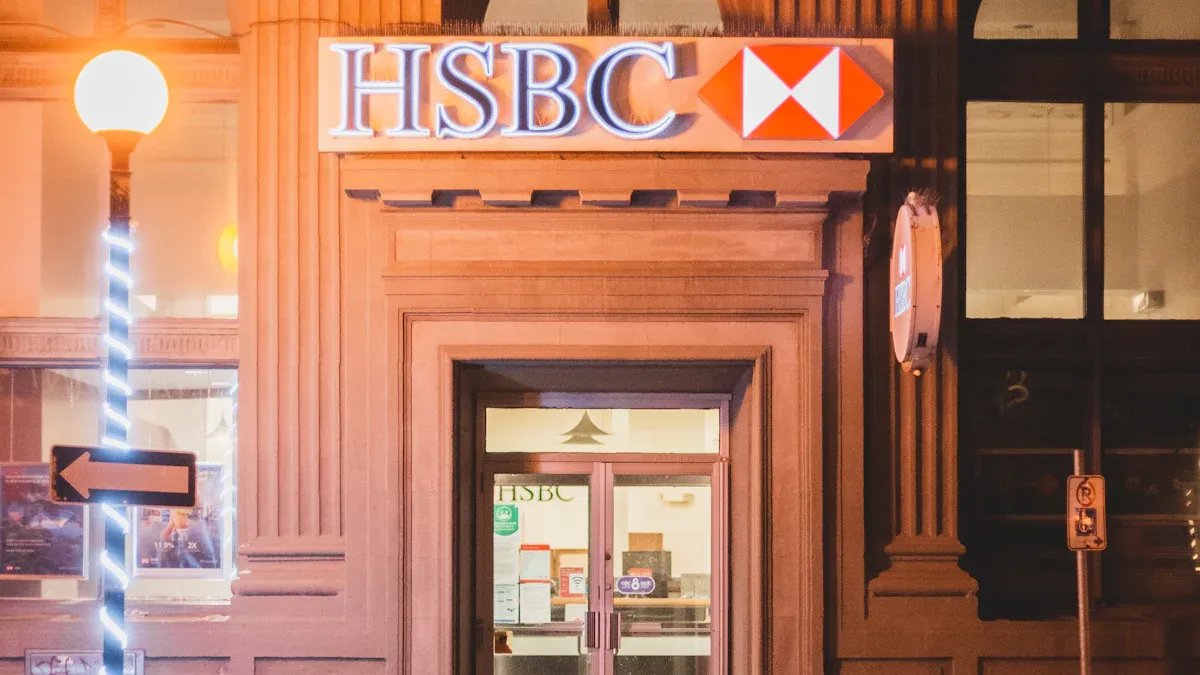- EasyCard
- Trade
- Help
- Announcement
- Academy
- SWIFT Code
- Iban Number
- Referral
- Customer Service
- Blog
- Creator
Comprehensive Guide to Hong Kong Bank Branch Codes and Bank Codes

Image Source: unsplash
“The 2025 latest Hong Kong bank branch codes and bank codes” are uniformly managed by the Hong Kong Interbank Clearing Limited. Correctly using branch codes helps ensure smooth fund transfers and telegraphic transfers to designated accounts. In daily life, whether opening a new account or processing interbank transfers, everyone needs to accurately fill in the relevant details. The public can check the latest information on official websites to ensure secure and error-free operations.
Key Points
- Bank codes and branch codes are critical for ensuring accurate fund transfers; both must be correctly filled to avoid fund returns or delays.
- The public can check the latest and accurate bank codes and branch codes through the Hong Kong Interbank Clearing Limited’s official website, bank websites, customer service hotlines, and bank statements.
- Different banks and their branches have unique three-digit bank codes and branch codes; understanding and using the correct codes helps ensure fund security.
- When filling in bank details, carefully verify to avoid errors such as missing digits, incorrect placement, or using outdated information, reducing the risk of fees and transaction delays.
- Regularly updating and confirming branch code information, especially after branch mergers or relocations, ensures smooth transfers and protects personal financial security.
Branch Code Overview

Image Source: pexels
Major Banks
Major Hong Kong banks include Bank of China (Hong Kong), HSBC, Hang Seng Bank, Standard Chartered Bank, Bank of East Asia, Citibank, China Minsheng Bank, Dah Sing Bank, Chiyu Banking Corporation, DBS Bank, OCBC Wing Hang Bank, and Ant Bank. Each bank has a unique bank code and assigns exclusive branch codes to its branches. These details are managed by the Hong Kong Interbank Clearing Limited, and the public can download the latest Excel files from its official website.
Tip: Correctly filling in bank codes and branch codes helps ensure funds are accurately transferred to the designated account, avoiding returns or delays due to incorrect information.
The table below lists the bank codes and common branch code examples for major banks in 2025:
| Bank Name | Bank Code | Common Branch Code Examples | Remarks |
|---|---|---|---|
| Bank of China (Hong Kong) | 012/014/019 | 012-123, 014-456 | Different branches have different codes |
| HSBC | 004 | 004-123, 004-456 | |
| Hang Seng Bank | 024 | 024-123, 024-456 | |
| Standard Chartered Bank | 003 | 003-123, 003-456 | |
| Bank of East Asia | 015 | 015-123, 015-456 | |
| Citibank | 250 | 250-123, 250-456 | |
| China Minsheng Bank | 391 | 391-123, 391-456 | |
| Dah Sing Bank | 040 | 040-123, 040-456 | |
| Chiyu Banking Corporation | 035 | 035-123, 035-456 | |
| DBS Bank | 185 | 185-123, 185-456 | |
| OCBC Wing Hang Bank | 016 | 016-123, 016-456 | |
| Ant Bank | 248 | 248-123, 248-456 |
Local and Foreign Banks
Hong Kong hosts multiple local and foreign banks. Each bank has unique bank codes and branch codes. These codes play a crucial role in local transfers and interbank remittances. Bank codes identify the banking institution, while branch codes specify the individual branch. Both are three-digit numbers. The public must accurately fill in both bank and branch codes during transfers. Incorrect details may result in funds being returned, causing transaction delays or additional fees.
- Bank websites, customer service, and online payment platforms provide ways to check bank and branch codes, helping users ensure accurate transfer details.
- Bank codes are identifiers for Hong Kong financial institutions, e.g., HSBC is 004, Hang Seng Bank is 024, and Bank of China (Hong Kong) has multiple codes like 012, 014, and 019.
- Each bank’s branches have unique branch codes, e.g., HSBC’s Mong Kok branch and Central branch have different branch codes.
The public can check and download the latest branch code Excel files on the Hong Kong Interbank Clearing Limited’s official website to ensure data accuracy.
Bank Codes and Branch Codes
Definition
A bank code is a set of numbers used to identify different banks. Hong Kong’s bank codes are typically three digits. For example, HSBC’s bank code is 004, and Bank of China (Hong Kong) has codes 012, 014, and 019. These numbers help the financial system quickly distinguish each bank.
Branch codes are numbers used to identify different branches within a bank. Each bank assigns a unique branch code to each of its branches. These codes are also three digits. Banks use branch codes alongside bank codes to ensure funds reach the designated branch accurately.
Fact: The combination of bank codes and branch codes acts like a bank’s “address,” ensuring funds don’t go to the wrong place.
Uses
Bank codes and branch codes have multiple uses in daily life. When the public makes local transfers, interbank remittances, or telegraphic transfers, the banking system processes fund flows based on these codes. For example, when a user transfers funds from HSBC to Bank of China (Hong Kong), they need to fill in the recipient bank’s bank code and branch code. This ensures funds are correctly deposited into the recipient’s designated branch.
Bank codes are mainly used to identify the banking institution itself. Branch codes further specify the individual branch. Both must be used together to ensure funds are accurately deposited into the recipient’s account. If only the bank code is provided without the branch code, funds may be delayed or returned.
- Bank codes and branch codes are essential in financial operations like clearing, telegraphic transfers, and automated transfers.
- Hong Kong banks clearly list these codes on bank statements, online banking, and official websites for easy access.
Tip: Before each transfer or remittance, users should double-check the branch code to ensure accuracy and reduce errors.
Branch Code Format

Image Source: unsplash
Bank of China (Hong Kong)
Bank of China (Hong Kong)’s branch codes are three digits, e.g., “999.” Each branch has a unique branch code. Account numbers are typically eight digits, e.g., “99999999.” When filling in transfer details, the public needs to input both the bank code (e.g., 012) and the branch code to ensure funds reach the recipient’s account accurately.
HSBC
HSBC’s branch codes are also three digits, e.g., “123.” Account numbers are eight or nine digits, e.g., “45678900” or “123456789.” Different branches have distinct branch codes, and users can check branch lists and the latest operating hours on HSBC’s official website.
Hang Seng Bank
Hang Seng Bank’s branch codes are three digits, e.g., “371.” Account numbers are seven or nine digits, e.g., “333336668.” Some branches, like the Tseung Kwan O branch, have recently adjusted operations, and users should check official announcements.
Standard Chartered Bank
Standard Chartered Bank’s branch code format is similar to other major banks, using three digits. Account numbers are typically eight or nine digits. The public can check branch addresses and the latest service hours on Standard Chartered’s website.
Other Banks
Other Hong Kong banks, such as Bank of East Asia, Dah Sing Bank, Nanyang Commercial Bank, Bank of Communications, Chong Hing Bank, Chiyu Banking Corporation, and Wing Lung Bank, use three-digit branch codes. Account number lengths vary by bank, typically ranging from seven to nine digits. Some banks, like OCBC, publish branch addresses and operating hours on their websites for easy access.
Tip: The table below summarizes the branch code formats and account number examples for major banks, facilitating comparison.
| Bank Name | Bank Code | Branch Code Format | Account Number Length Example |
|---|---|---|---|
| Bank of China | 012 | 3 digits (e.g., 999) | 8 digits (e.g., 99999999) |
| HSBC | 004 | 3 digits (e.g., 123) | 8 or 9 digits (e.g., 45678900) |
| Hang Seng Bank | 024 | 3 digits (e.g., 371) | 7 or 9 digits (e.g., 333336668) |
| Bank of East Asia | 015 | 3 digits (e.g., 150) | 8 or 9 digits (e.g., 889999999) |
| Dah Sing Bank | 040 | 3 digits (e.g., 716) | 7 or 8 digits (e.g., 88888888) |
| Nanyang Commercial Bank | 043 | 3 digits (e.g., 999) | 8 digits (e.g., 99999999) |
| Bank of Communications | 382 | 3 digits (e.g., 888) | 9 digits (e.g., 888888888) |
| Chong Hing Bank | 041 | 3 digits (e.g., 284) | 9 digits (e.g., 200335955) |
| Chiyu Banking Corporation | 039 | 3 digits (e.g., 745) | 8 digits (e.g., 00088000) |
| Wing Lung Bank | 020 | 3 digits (e.g., 699) | 8 digits (e.g., 12345678) |
When processing transfers or opening accounts, the public should input the correct branch codes and account numbers based on official bank information to reduce the risk of errors.
How to Check Branch Codes
Official Websites
The public can check the latest branch codes on the Hong Kong Interbank Clearing Limited’s official website. The website provides a list of all Hong Kong banks’ bank codes and branch codes, and users can directly download Excel files. Major banks like HSBC, Bank of China (Hong Kong), and Hang Seng Bank also have dedicated branch information pages on their websites. The Hong Kong Monetary Authority and financial information platforms also periodically update related data for public access.
Tip: When checking, pay attention to the update date of the information to ensure the branch code used is the latest version.
Customer Service Hotline
Many banks offer 24-hour customer service hotlines. If the public has questions about branch codes, they can call the bank’s hotline for assistance. Customer service staff can help find the correct branch code based on the branch name or address provided by the user. This method is suitable for those unfamiliar with online operations or needing immediate help.
- Customer service hotline numbers are typically found on bank cards, statements, or bank websites.
- When inquiring, it’s recommended to have the branch name or address ready for quick assistance.
Bank Statements/Online Banking
Monthly bank statements usually list the branch code associated with the account. Users can also log into online banking or mobile banking apps to check this information on the account details page. These methods are simple and direct, ideal for those who frequently use digital banking services.
Tip: Before making transfers or telegraphic transfers, check the branch code on statements or online banking to minimize errors.
Code Comparison
Bank Codes
Bank codes are three-digit numbers used to identify different Hong Kong banks. For example, HSBC’s bank code is 004, and Bank of China (Hong Kong) has codes 012, 014, and 019. Bank codes are crucial for local transfers. Users need to input the correct bank code for the banking system to direct funds to the right bank. According to official information, some agricultural and fishery associations share the same bank code. This sharing does not affect transfer transactions. Users can enter the financial institution code on the FISC website to check the corresponding institution name. However, the data source for bank codes cannot clearly reflect differences in their use during transfers.
Branch Codes
Branch codes are three-digit numbers used within a bank to distinguish different branches. Each branch has a unique branch code. When making local transfers or opening accounts, banks require branch codes to be filled in. This ensures funds reach the recipient’s designated branch accurately. Branch codes and bank codes must be used together to complete accurate fund transfers.
SWIFT/IBAN
SWIFT codes are 8 to 11-character codes consisting of letters and numbers used for international bank identification. Hong Kong banks use SWIFT codes for overseas remittances. This code allows the international banking system to accurately locate the recipient bank. IBAN is an international bank account number, mainly used in Europe and some countries. Hong Kong banks generally do not use IBAN, but users may need to provide it when remitting to European countries.
Tip: For local transfers, use bank codes and branch codes. For overseas remittances, use SWIFT codes and, if required, IBAN.
| Code Type | Purpose | Scope |
|---|---|---|
| Bank Code | Identify the bank | Local transfers |
| Branch Code | Identify the bank branch | Local transfers |
| SWIFT | International bank identification | Overseas remittances |
| IBAN | International account number | Europe and some countries |
When choosing a transfer method, the public should select the appropriate code based on the fund’s destination. Local transfers primarily use bank codes and branch codes. Overseas remittances require SWIFT codes, and some countries also need IBAN. Using the correct codes ensures funds reach their destination safely and quickly.
Common Errors and Tips
Filling Precautions
Many people make errors when filling in bank details. The most common issues include confusing bank codes with branch codes, copying errors, or omitting digits. Some users copy old data without verifying the latest official information. These errors can prevent successful transfers or result in returns, incurring additional fees.
Tip: Always double-check all digits, especially bank and branch codes, when filling in bank details. Refer to bank statements or official websites to ensure accuracy.
Common errors include:
- Mixing up the positions of bank codes and branch codes
- Omitting or adding extra digits
- Using outdated or discontinued branch information
- Ignoring discrepancies between branch names and actual branch codes
Avoiding Errors
The public can take several steps to reduce errors. First, regularly check the Hong Kong Interbank Clearing Limited and major banks’ official websites for the latest branch information. Second, before transferring, call the bank’s customer service or check statements to confirm branch details.
Tip: If a branch merges, relocates, or closes, banks will announce updated branch information on their websites, and users should update their records promptly.
Recommended habits include:
- Verify branch details before each transfer
- Regularly update personal records to avoid using outdated information
- Contact bank customer service for clarification if in doubt
- Save official website links for easy access
These practices can effectively reduce losses due to incorrect information, ensuring funds reach the designated account securely.
This article summarizes key information about Hong Kong bank branch details. Readers should regularly check official websites to ensure data accuracy and updates. Multiple inquiry methods are available, with official channels being the most reliable. They can bookmark this article for future reference or share it with friends and family. Branch codes are crucial for daily financial management and transfers, and correct usage ensures fund security.
FAQ
What’s the difference between bank branch codes and bank codes?
Bank codes identify the bank. Branch codes specify individual branches within the bank. Together, they ensure accurate transfer processing.
How can I find my account’s branch code?
The public can log into online banking or check bank statements. Bank websites and customer service hotlines also provide branch code information.
What happens if I enter the wrong branch code?
Entering the wrong branch code may result in funds being returned or delayed. Banks may charge additional fees, approximately USD10-USD30, depending on exchange rates.
What information is needed for overseas remittances?
Overseas remittances typically require bank codes, branch codes, and SWIFT codes. Some countries also require IBAN.
Do branch codes change frequently?
Banks occasionally change branch codes due to mergers or relocations. The public should regularly check official websites for the latest information.
Hong Kong bank branch codes (e.g., HSBC 004, Hang Seng 024) ensure precise and secure local transfers, but high cross-border remittance fees and branch data updates can hinder global wealth management efficiency—how can you bridge local and international fund flows? BiyaPay offers an all-in-one financial platform, enabling seamless trading of leading Hong Kong and US market enterprises without offshore accounts, extending the reliability of local bank branch services to global investments in financial and tech sectors.
Supporting USD, HKD, and 30+ fiat and digital currencies, real-time exchange rate tracking ensures cost transparency, while global remittances to 190+ countries feature transfer fees as low as 0.5%, significantly below traditional bank costs, with swift delivery to meet global wealth needs. A 5.48% annualized yield savings product, with no lock-in period, balances market volatility with steady returns. Sign up for BiyaPay today to integrate local bank branch code precision with BiyaPay’s worldwide financial solutions, creating a secure, efficient wealth management experience!
*This article is provided for general information purposes and does not constitute legal, tax or other professional advice from BiyaPay or its subsidiaries and its affiliates, and it is not intended as a substitute for obtaining advice from a financial advisor or any other professional.
We make no representations, warranties or warranties, express or implied, as to the accuracy, completeness or timeliness of the contents of this publication.




Contact Us
Company and Team
BiyaPay Products
Customer Services
is a broker-dealer registered with the U.S. Securities and Exchange Commission (SEC) (No.: 802-127417), member of the Financial Industry Regulatory Authority (FINRA) (CRD: 325027), member of the Securities Investor Protection Corporation (SIPC), and regulated by FINRA and SEC.
registered with the US Financial Crimes Enforcement Network (FinCEN), as a Money Services Business (MSB), registration number: 31000218637349, and regulated by FinCEN.
registered as Financial Service Provider (FSP number: FSP1007221) in New Zealand, and is a member of the Financial Dispute Resolution Scheme, a New Zealand independent dispute resolution service provider.




















